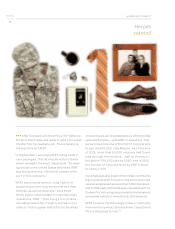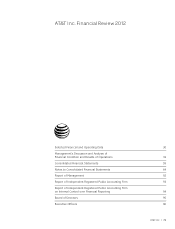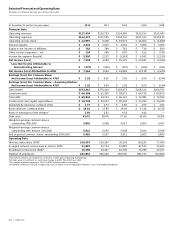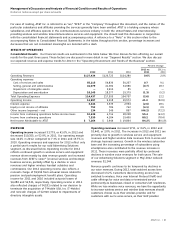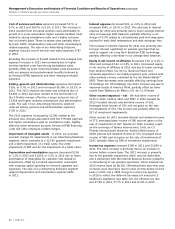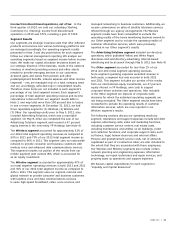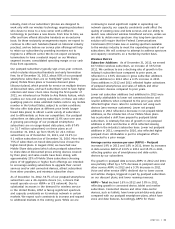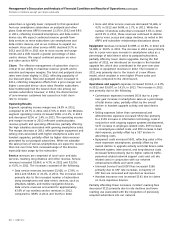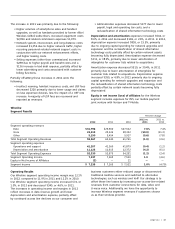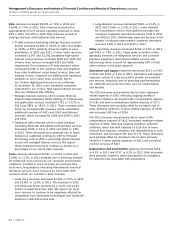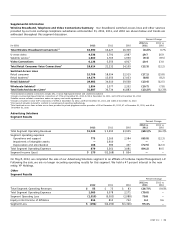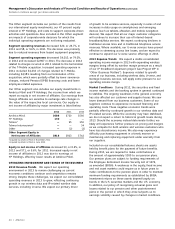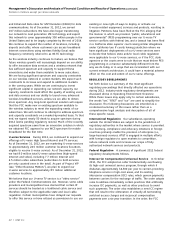AT&T Wireless 2012 Annual Report Download - page 37
Download and view the complete annual report
Please find page 37 of the 2012 AT&T Wireless annual report below. You can navigate through the pages in the report by either clicking on the pages listed below, or by using the keyword search tool below to find specific information within the annual report.
AT&T Inc. | 35
continuing to invest significant capital in expanding our
network capacity, our capacity constraints could affect the
quality of existing voice and data services and our ability to
launch new, advanced wireless broadband services, unless we
are able to obtain more spectrum. Any long-term spectrum
solution will require that the Federal Communications
Commission (FCC) make new or existing spectrum available
to the wireless industry to meet the expanding needs of our
subscribers. We will continue to attempt to address spectrum
and capacity constraints on a market-by-market basis.
Wireless Metrics
Subscriber Additions As of December 31, 2012, we served
107 million wireless subscribers, an increase of 3.6% from
2011. We continue to see a declining rate of growth in the
industry’s subscriber base compared to prior years, as
reflected in a 13.0% decrease in gross subscriber additions
(gross additions) in 2012 after a 4.3% increase in 2011.
Gross additions in 2012 and 2011 reflected higher activations
of postpaid smartphones and sales of tablets and other
data-centric devices compared to prior years.
Lower net subscriber additions (net additions) in 2012 were
primarily attributable to lower net connected device and
reseller additions when compared to the prior year, which
reflected higher churn rates for customers not using such
devices (zero-revenue customers). Lower net prepaid
additions in 2012 reflected a decrease in net prepaid tablet
additions, as the introduction of our Mobile Share plans
has accelerated a shift from prepaid to postpaid tablet
subscribers. A relatively flat rate of growth in net postpaid
additions in 2012 and decline in 2011 reflected slowing
growth in the industry’s subscriber base. Lower net postpaid
additions in 2011, compared to 2010, also reflected higher
postpaid churn attributable in part to integration efforts
connected to a prior merger.
Average service revenue per user (ARPU) – Postpaid
increased 1.9% in 2012 and 1.8% in 2011, driven by increases
in data services ARPU of 13.9% in 2012 and 15.3% in 2011,
reflecting greater use of smartphones and data-centric
devices by our subscribers.
The growth in postpaid data services ARPU in 2012 and 2011
was partially offset by a 5.7% decrease in postpaid voice and
other service ARPU in 2012 and a 5.3% decrease in 2011.
Voice and other service ARPU declined due to lower access
and airtime charges, triggered in part by postpaid subscribers
on our discount plans, and lower roaming revenues.
ARPU – Total declined 1.6% in 2012 and 3.8% in 2011,
reflecting growth in connected device, tablet and reseller
subscribers. Connected devices and other data-centric
devices, such as tablets, have lower-priced data-only plans
compared with our postpaid smartphone plans, which have
voice and data features. Accordingly, ARPU for these
industry, most of our subscribers’ phones are designed to
work only with our wireless technology, requiring subscribers
who desire to move to a new carrier with a different
technology to purchase a new device. From time to time, we
offer and have offered attractive handsets on an exclusive
basis. As these exclusivity arrangements expire, we expect to
continue to offer such handsets (based on historical industry
practice), and we believe our service plan offerings will help
to retain our subscribers by providing incentives not to
migrate to a different carrier. We do not expect exclusivity
terminations to have a material impact on our Wireless
segment income, consolidated operating margin or our cash
flows from operations.
Our postpaid subscribers typically sign a two-year contract,
which includes discounted handsets and early termination
fees. As of December 31, 2012, about 90% of our postpaid
smartphone subscribers are on FamilyTalk® plans (family
plans), Mobile Share plans or business discount plans
(discount plans), which provide for service on multiple devices
at discounted rates, and such subscribers tend to have higher
retention and lower churn rates. During the first quarter of
2011, we introduced our Mobile to Any Mobile feature, which
enables our new and existing subscribers on these and other
qualifying plans to make unlimited mobile calls to any mobile
number in the United States, subject to certain conditions.
We also offer data plans at different price levels (usage-
based data plans) to attract a wide variety of subscribers
and to differentiate us from our competitors. Our postpaid
subscribers on data plans increased 11.4% year over year.
A growing percentage of our postpaid smartphone
subscribers are on usage-based data plans, with 67.4%
(or 31.7 million subscribers) on these plans as of
December 31, 2012, up from 56.0% (or 22.1 million
subscribers) as of December 31, 2011, and 31.2% (or
9.1 million subscribers) as of December 31, 2010. More than
75% of subscribers on tiered data plans have chosen the
higher-tiered plans. In August 2012, we launched new
Mobile Share data plans (which allow postpaid subscribers
to share data at discounted prices among devices covered
by their plan), and sales results have been strong, with
approximately 25% of Mobile Share subscribers choosing
plans of 10 gigabytes or higher. Such offerings are intended
to encourage existing subscribers to upgrade their current
services and/or add connected devices, attract subscribers
from other providers, and minimize subscriber churn.
As of December 31, 2012, 54.7% of our postpaid smartphone
subscribers use a 4G-capable device (i.e., a device that
would operate on our HSPA+ or LTE network). Due to
substantial increases in the demand for wireless service
in the United States, AT&T is facing significant spectrum
and capacity constraints on its wireless network in certain
markets. We expect such constraints to increase and expand
to additional markets in the coming years. While we are





